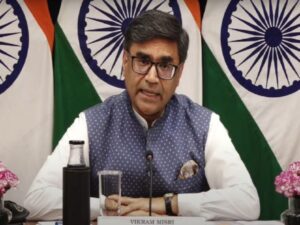Nine reasons why one of the World’s biggest money management group thinks India’s economic story is on the rise
Los Angeles [US], July 15 (ANI): Prime Minister Narendra Modi’s recent visit to the United States shows India’s significance as a rising global power, where he addressed Congress, met with high-profile business leaders and dined at the White House, reported Capital Group.
The growth parameters of India are pointing in the right direction with high Corporate confidence, expansion of the economy and technological advancement and innovation.
India has witnessed relative political stability over the past 10 years, allowing economic development to be a top priority, as per Capital Group.
Capital Group is a private firm that aims to improve people’s lives through successful investing and take control of their financial futures. It is one of the world’s largest investment management organisations.
The Capital Group believes that India is poised for a period of growth, fuelled by significant expansion in direct and fixed asset investment which can be attributed to the maximum numbers of unicorns emerging in India.
Here are some of the key aspects that make India appealing business destination compared with other emerging markets :-
1. Reforms have set the stage for growthSince Prime Minister Narendra Modi took office in 2014, he and his team have helped usher in pro-business reforms that have accelerated growth by facilitating the expansion of credit and bringing large swaths of the economy into the formal sector which can be seen in the major changes made in ease of doing business.
Several reforms and programmes launched in the leadership of PM Modi like Aadhaar, a national Goods and Services Tax (GST), Unified Payments Interface (UPI) are helping boost consumer lending, replacing inefficient web of state taxes and facilitating electronic transactions and provide credit respectively as well as making the process more transparent.
Production-linked incentive programs designed to elevate India’s domestic manufacturing base are gaining traction too. PM Modi has delivered in terms of governance, infrastructure and economic programs. India is projected to become the world’s third-largest economy behind the United States and China by 2027, according to the International Monetary Fund. It’s currently the fifth largest, after Japan and Germany, as per Capital Group.
2. The infrastructure boom is realThe lack of infrastructure has been a major impediment to unlocking India’s true growth potential. Over the past five years, the government has pumped billions into building up of roads, railroads, airports and seaports.
Capital Group has found that the construction of infrastructure as well as more affordable housing is finally happening.
In Mumbai, the skyline is unrecognizable from 15 years ago. Dozens of buildings reach 50 or more floors, and a subway system is under construction. Residential housing is fast expanding.
As an example, the town of Palava, 20 miles from Mumbai’s central business district, is a master-planned community that reminds us of what we used to see in China. In 15 years, Palava has gone from a concept to a city of 120,000 residents.
Such things were unheard of just a decade earlier, according to Capital Group.
3. Tailwinds for manufacturing are getting strongerThe playbook for the Indian government is twofold: ramp up capacity to serve the domestic population and over time become a larger player in export markets. Leaders also want to develop a supply chain ecosystem, as a wide array of product components are imported.
Manufacturing capacity is expanding for mobile phones, home appliances, computers and telecommunications equipment. PM Modi’s team has been aggressive in courting Japanese, Taiwanese and US companies to invest in new capacity.
Moreover, Apple is producing its iPhone 14 line in India, while Japanese companies Daikin and Mitsubishi Electric are teeing up investments to make air conditioners and related parts.
Local firms have been investing heavily to scale up businesses and tap into the rapidly growing domestic market.
Overall, manufacturing is getting easier. Securing government approvals for land is less onerous, labor is affordable and industrial parks are creating dedicated power sources (consistent power availability has historically been a big challenge).
Capital Group anticipates India will become a desirable location for companies looking to diversify their supply chains outside of China, a strategy commonly known as China plus one.
4. India's equity market has been growing and should evolveWithin the MSCI Emerging Markets Index, India represents 14 per cent of the composite index, behind China at 29 per cent and Taiwan at 16.2 per cent.
Capital Group expects potential investment opportunities to increase, especially in the small-cap space given India’s economic trajectory.
India’s capital markets have seen a proliferation of initial public offerings (IPOs) in recent years. The types of companies going public — and those in the IPO pipeline — reflect its ongoing transformation.
India is now behind only the US and China in terms of the number of unicorns (unlisted companies valued at USD 1 billion) as of December 2022.
5. Investment opportunities span real estate, financials and industrialsReal estate: India, which the UN projected in April will overtake China as the world’s most populous country this year, is a massively underhoused society. Housing is expected to be a key driver — and beneficiary — of the economy’s growth.
According to Capital Group, real estate is projected to rise to nearly 15 per cent of India’s gross domestic product (GDP) by fiscal year 2031, up from 7 per cent currently.
The sector is undergoing a dramatic structural shift, which should boost profits. Government policies have helped reform corrupt practices and build trust in the homebuying process among consumers.
The overall environment looks positive. Loan growth remains solid in both the retail and corporate categories, and the credit environment remains benign. India could be entering a favorable cycle for banks given the trajectory of the economy and several rounds of consolidation among weaker state-owned banks in recent years.
Capital Group believes there is sufficient potential for loan growth to offset margin compression given the expansion of credit and robust economic growth.
As mentioned, the Indian market has consolidated following a liquidity crisis several years ago, making it much more attractive from an investment perspective. Data gathering through the country’s technology infrastructure has helped to improve underwriting standards. This has the potential to be a large market, especially in areas of affordable housing and vehicles.
The telecommunications market has consolidated, effectively leaving conglomerate Reliance Industries and Bharti Airtel as the dominant players. Capital Group anticipates smartphone and data usage will continue to increase, especially as 5G and fiber-to-the-home technologies are rolled out in more cities.
6. China plus one: The chemicals industry sets a good exampleThe chemicals industry exemplifies how both governments and multinationals are turning to India to diversify manufacturing beyond China. Many chemical companies have come up over the past decade as the West sought to diversify its sourcing of both specialty and generic chemicals.
India’s competitive advantage has been its large pool of trained scientists and chemical engineers, which has enabled it to establish expertise in specialty and commoditized chemicals. This includes those being used in semiconductors, electric vehicle batteries and solar panels, where additional capacity is being built.
7. The energy transition could be transformationalIndian corporations are seeking to compete with China all along the value chain of clean energy, especially with green hydrogen.
The energy transition is potentially transformational for India. If done right, the payoff could be massive: India is a large importer of oil and gas, so more renewable power would make it more energy independent. It would also significantly boost its manufacturing base.
8. Demographics are the biggest advantageWhile India will very likely benefit from Western countries exploring China-plus sourcing strategies, the bulk of economic growth will come from domestic consumption and investment. With a median age of 29 years, India in Capital Group’s view has one of the most attractive demographic profiles among the world’s largest economies and can reap benefits from its productive capacity, provided the right policies are in place.
We have already seen that technological innovation combined with an improving regulatory and legal framework has put the nation’s economy on a path of 5 per cent to 6 per cent annualized growth, among the fastest of the world’s large economies.
9. Valuations are stretched but not insurmountableWhen it comes to investing in emerging markets, India has historically traded at a premium on a relative price-to-earnings basis. Currently, the market looks a little expensive by historical standards. The MSCI India Index trades at 20 times forward earnings versus its 10-year average of 18 times.
That said, Capital Group said it believes the fundamental outlook for India is arguably better than ever. The market has a lot going for it: It’s one of the world’s fastest growing economies, inflation is under control, the government has been fiscally responsible, and corruption is lower than it was a decade ago. If Indian companies can deliver on earnings and cash flows, we think it’s possible the market can grow into these valuations.
The path of India’s equities has never been a straight line, but over longer periods, the stock market has delivered some of the best returns among emerging and developed markets, according to Capital Group.






